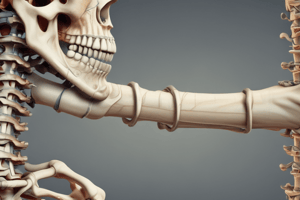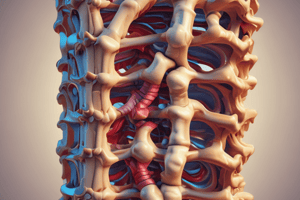Podcast
Questions and Answers
Which type of articulation permits no movement?
Which type of articulation permits no movement?
- Synchondrosis (correct)
- Cartilaginous synarthrosis
- Fibrous synarthrosis
- Symphysis
What type of joint is formed by bones joined by a ligament or band of connective tissue?
What type of joint is formed by bones joined by a ligament or band of connective tissue?
- Cartilaginous amphiarthrosis
- Syndesmosis (correct)
- Fibrous amphiarthrosis
- Symphysis
Which type of joint capsule encloses the joint space?
Which type of joint capsule encloses the joint space?
- Articular cartilages
- Periosteum
- Fibrous joint capsule (correct)
- Articular ligament
In which type of articulation do two bones become one through bony fusion?
In which type of articulation do two bones become one through bony fusion?
Which plane separates the body into right and left portions?
Which plane separates the body into right and left portions?
What does the transverse plane separate the body into?
What does the transverse plane separate the body into?
Which structure is an unpaired, left-sided organ?
Which structure is an unpaired, left-sided organ?
What do cranial nerves arise from?
What do cranial nerves arise from?
What do spinal nerves arise from?
What do spinal nerves arise from?
What do dermatomes and myotomes represent?
What do dermatomes and myotomes represent?
What encloses the central nervous system?
What encloses the central nervous system?
How are spinal nerves named?
How are spinal nerves named?
What does the cauda equina refer to?
What does the cauda equina refer to?
Which of the following is an example of anatomical relationships?
Which of the following is an example of anatomical relationships?
What is included in regional nomenclature?
What is included in regional nomenclature?
What does the spinal cord consist of?
What does the spinal cord consist of?
Which type of movement is not exhibited by synovial joints?
Which type of movement is not exhibited by synovial joints?
What is the function of synovial fluid in synovial joints?
What is the function of synovial fluid in synovial joints?
Which of the following is an intrinsic ligament of a synovial joint?
Which of the following is an intrinsic ligament of a synovial joint?
What is the relationship between stability and mobility in joints?
What is the relationship between stability and mobility in joints?
Which type of joint allows the greatest range of motion?
Which type of joint allows the greatest range of motion?
Which part of the skeleton houses the brain?
Which part of the skeleton houses the brain?
Which bones form the cranium and face?
Which bones form the cranium and face?
What part of the temporal bone contributes to the temporomandibular joint (TMJ)?
What part of the temporal bone contributes to the temporomandibular joint (TMJ)?
Which structure is located on the base of the cranium?
Which structure is located on the base of the cranium?
Which bone forms part of the base of the cranium and contains the hypophyseal fossa?
Which bone forms part of the base of the cranium and contains the hypophyseal fossa?
Which bone contributes to the structure of the skull's superior view?
Which bone contributes to the structure of the skull's superior view?
Which part of the skull surrounds the entrances to the digestive and respiratory tracts?
Which part of the skull surrounds the entrances to the digestive and respiratory tracts?
Which part of the spinal cord is the site for cerebrospinal fluid (CSF) sampling in a lumbar puncture?
Which part of the spinal cord is the site for cerebrospinal fluid (CSF) sampling in a lumbar puncture?
Where is epidural anesthesia administered?
Where is epidural anesthesia administered?
What carries sensory information upward and motor information downward in the spinal cord?
What carries sensory information upward and motor information downward in the spinal cord?
Which part of the spinal cord is organized into columns delineated by sulci?
Which part of the spinal cord is organized into columns delineated by sulci?
Where are the enlarged ventral horns present in the spinal cord?
Where are the enlarged ventral horns present in the spinal cord?
What do dorsal roots carry?
What do dorsal roots carry?
What do ventral roots carry?
What do ventral roots carry?
What do spinal nerves contain?
What do spinal nerves contain?
What are somatic nerve plexuses formed by?
What are somatic nerve plexuses formed by?
What is the region where the amount of white matter decreases in the rostrocaudal direction?
What is the region where the amount of white matter decreases in the rostrocaudal direction?
What is the site for the union of dorsal and ventral roots in the spinal cord?
What is the site for the union of dorsal and ventral roots in the spinal cord?
Which part of the spinal cord houses the filum terminale interna and filum terminale externa?
Which part of the spinal cord houses the filum terminale interna and filum terminale externa?
Which part of the spinal column houses the temporal lobes of the brain?
Which part of the spinal column houses the temporal lobes of the brain?
How many thoracic vertebrae are there in the spinal column?
How many thoracic vertebrae are there in the spinal column?
Which curves of the spinal column develop prenatally?
Which curves of the spinal column develop prenatally?
What are the parts of a typical vertebra?
What are the parts of a typical vertebra?
What do intervertebral articulations involve?
What do intervertebral articulations involve?
What are intervertebral discs made of?
What are intervertebral discs made of?
What are the Atlas (C1) and Axis (C2) in the spinal column?
What are the Atlas (C1) and Axis (C2) in the spinal column?
What is the function of the sacrum and coccyx?
What is the function of the sacrum and coccyx?
What is essential for precise communication in anatomical descriptions?
What is essential for precise communication in anatomical descriptions?
Which plane is used to separate the body into anterior and posterior portions?
Which plane is used to separate the body into anterior and posterior portions?
What is the directional term for 'toward the tail'?
What is the directional term for 'toward the tail'?
Which part of the spinal column articulates with the lower limb?
Which part of the spinal column articulates with the lower limb?
Flashcards are hidden until you start studying
Study Notes
Anatomy of the Spinal Column
- The middle cranial fossa houses the temporal lobes of the brain, while the posterior cranial fossa houses the cerebellum.
- The spinal column consists of 7 cervical, 12 thoracic, 5 lumbar, 5 sacral, and 3-5 coccygeal vertebrae, each with specific functions and characteristics.
- The spinal curves include primary curves (thoracic and sacral) that develop prenatally, and secondary curves (cervical and lumbar) that develop postnatally.
- A typical vertebra consists of various parts, such as the vertebral body, vertebral arch, pedicles, laminae, spinous process, and transverse processes.
- Structural variations in vertebrae reflect regional specializations in function, such as load-bearing capacity and spinal cord diameter.
- The Atlas (C1) and Axis (C2) are specialized vertebrae with unique features, including superior articular facets and transverse foramina.
- Intervertebral articulations involve the vertebral canal, intervertebral foramina, and zygapophyseal joints, allowing slight gliding movements between vertebrae.
- Intervertebral discs consist of a fibrocartilaginous anulus fibrosus and a gelatinous core (nucleus pulposus), providing cushioning and flexibility.
- The sacrum and coccyx are fused vertebrae with specific functions, including articulation with the lower limb and protection of pelvic viscera.
- The anatomical position and directional nomenclature are essential for precise communication in anatomical descriptions, involving terms like cranial, caudal, dorsal, ventral, lateral, and medial.
- The frontal or coronal plane is used to separate the body into anterior and posterior portions, aiding in anatomical descriptions and sectional nomenclature.
- Understanding the precise language and directional terms is crucial for effective communication in the study and description of human anatomy.
Studying That Suits You
Use AI to generate personalized quizzes and flashcards to suit your learning preferences.




